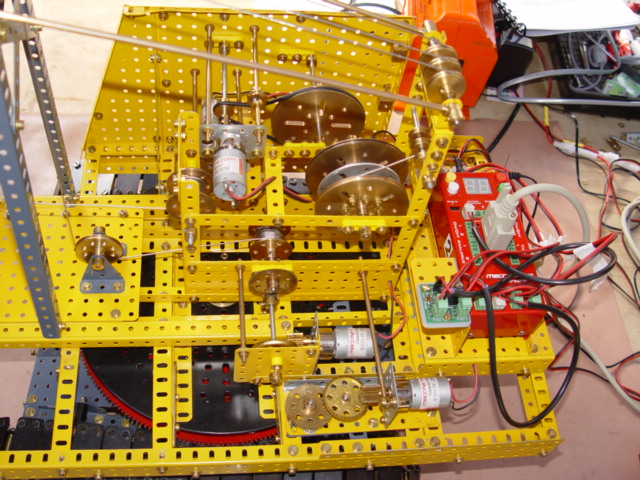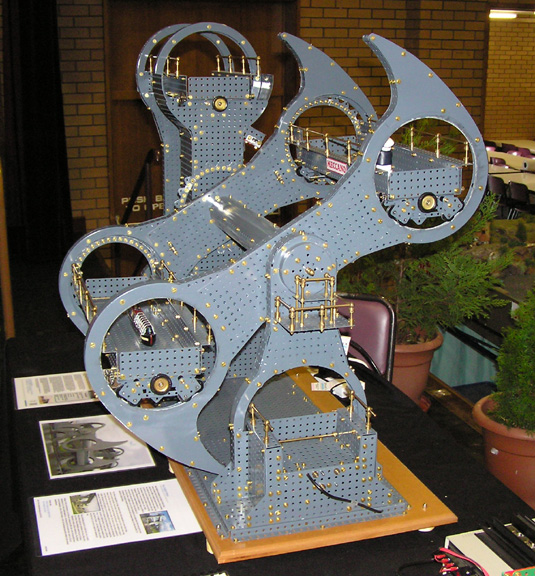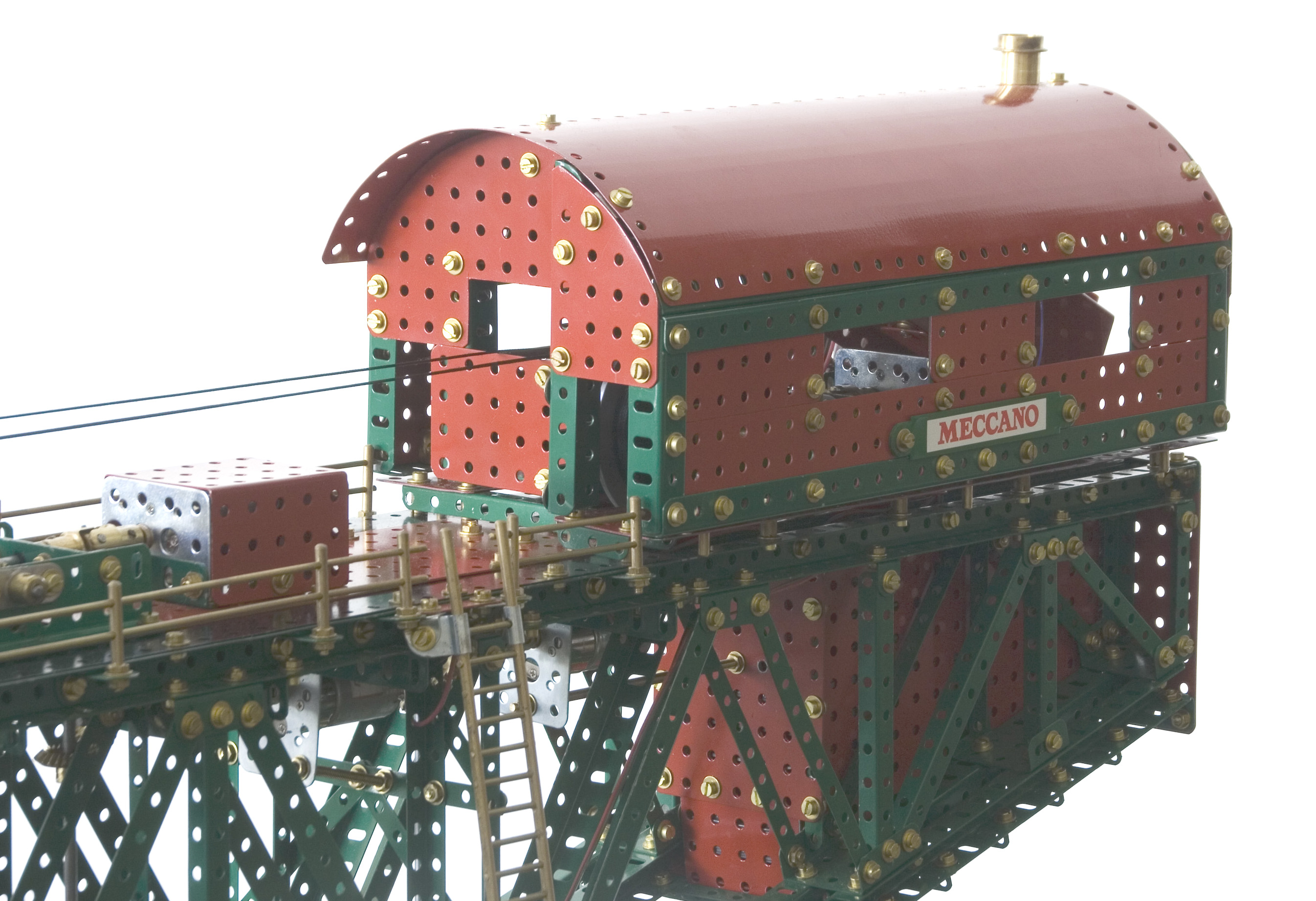| Bagger Excavator |
 |  |  |  |
| Cable Operated Digger with Big Bucket.
The Model is constructed of replica Meccano Parts it is a copy of the Marklin outfit 10900 produce for their 90th anniversary in 2004 with the addition of 5 motors and a Geared Roller Bearing.
The original outfit was a typical Marklin model where you had to operate it by hand.
I saw the model as project that could be motorise and controlled by the Motoravator which is controlled by a computer program.
|
| |
| Climax Locomotive |
 |  |  | |
| Built in the US in 1928, the Climax was shipped to Australia and entered service on the narrow-gauge timber tramway in the Tyers Valley,Gippsland, hauling logs along the 11-kilometre track between Tyers Junction and Collins Siding,where the timber tramway joined the Moe-Walhalla railway.
Climax loco number 1694 hauled its last train in 1950,and for the next 12years slowly rusted in the open before being presented to the Puffing Billy Preservation Society as a staic exhibit.
But shrewd members of the society knew that of the 1100 Climax engines built,few had survived. And of those ,only a handful were still working.
So, in 1982, it was agreed to begin restoration.Now, $32000 later and with labors of a core of volunteers,the Climax is one of only six in the world still working.
Its wood-fired boiler can generate a top speed of only 9.65 kmh. |
| |
| Falkirk Wheel |
 |  |  |  |
| The Wheel is essentially two huge,balanced water tanks suspended on arms which rotate around a central axis like a Ferris wheel. Each tank can support up to four twenty-meter-long boats at one time.Boats move into the tanks through the lock gates, which displaces a mass of water from each tank equal to the weight of the vessels.the tanks are thus always equalized in weight,allowing the pull of gravity on the descending tank to do most of the work elevating the rising tank.This balance allows the wheel to consume very little electricity per turn despite the enormous weight involved.It uses a mere 1.5 kilowatt-hours or roughly the equivalent power needed to boil eight kettles of water-each time it hefts a 600 metric ton load. And it does this in under four minutes per turn. |
| |
| Fishguard Titan Giant Block-Setting Crane. |
 |  |  |  |
| This is an accurate scale model of the 'Titan'Giant Block-Setting Crane used to build Fishguard Habour between 1914 and 1916. The model is based on the original plans published in engineering journals in 1914 and 1916. |
| |
| Garratt Locomotive G42 |
 |  |  |  |
| PROTOYPE.
Having examined the possible use of articulated locomotives to reduce operating costs on narrow gauge lines,the Victorian Railways decided upon the Beyer- Garratt type and in 1925 an order was placed with Beyer Peacock Ltd. Gorton Works,Manchester,England,for two 2feet 6inch gauge engines of the 2-6-0+0-6-2 wheel arrangment.
The two Garratt locomotives arrived from England in May 1926 to be assembled at the Victorian Railways Workshops.Assembly of the new Garratts was duly completed and steaming trails carried out,the engines being classed G and giving the running numbers 41 and 42,since the fortiesseries of numbers was not in use for any other class at that time.
MODEL.
The scale I used is 1''to the foot I find that this scale is ideal for building narrow gauge Locomotives in Meccano.
Modern type side plate motors drive each bogie on the Locomotive model, reasonbeing is that I have set the Model up on supports for exhibitions so public can see the valve gear working.
Time spent building model approx. 375 hours. |
| |
| Horvinex 450-E Motorcycle |
 |  |  |  |
| Model Designed by Frank Weber of Germany
I built this Model from the photograph that was published in Constructor Quarterly No. 64 and also from photo's on Frank's webpage. |
| |
| Shay Narow Gauge Locomotive |
 |  |  |  |
| Ephraim Shay (1839-1916) operated a sawmill for the supply of bridge and building timbers.He was having problems with his brakeless two-bogie log car overrunning his horse on the downhill slopes.To control the log car he purchased a small locomotive only to find that its weight destroyed his rails.Then he noticed that the logcar,although weighing twice as much as the locomotive,did not damaged the rails.During the winter of 1880 he and his staff set about rebuilding the locomotive and after successive experiments found a solution by powering the two end bogies.This locomotive with its upright boiler proved to be rather successful in breaking the logcar and thus the "Shay"-type locomotive was born.Shay took out a patent in 1881 and he sold the manufacturing rights to the Lima Machine Works of Lima Ohio,U.S.A.,where all of the 2761 Shays were built, the last one going to Western Maryland in 1945.the vertical boiler was replaced by a horizontal boiler offset to the left and small bevel gears were moved to the front of the wheels.No two locomotives were identical,comming with 2 or 3 cylinders,with or without tender and in 2,3or4-powered bogie versions.These locomotives were.And still are very popular in the logging world and mountainous countries as far as Mexcio and China.
|
| |





















































